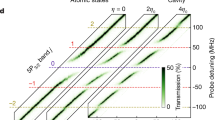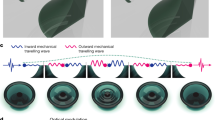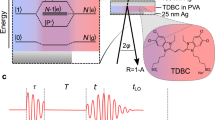Abstract
The strong coupling between photons and bosonic excitations in matter produces hybrid quasiparticle states known as polaritons1,2,3. Their signature is the avoided crossing between the eigenfrequencies of the coupled system illustrated by the Jaynes–Cummings Hamiltonian4. It has been observed in quantum electrodynamics experiments based on atoms5,6, ions7, excitons8,9,10, spin ensembles11,12 and superconducting qubits13. In cavity optomechanics, polariton modes originate from the quantum-coherent coupling of a macroscopic mechanical vibration to the cavity radiation field14,15. Here we investigate polaritonic modes in the motion of an optically levitated nanosphere16,17,18,19,20,21,22 in the quantum-coherent coupling regime. The particle is trapped in a high vacuum by an optical tweezer and strongly coupled to a single cavity mode by coherent scattering of the tweezer photons23,24,25,26,27. The two-dimensional motion and optical cavity mode define an optomechanical system with three degrees of freedom. In the strong-coupling regime, we observe hybrid light–mechanical states with a vectorial nature. Our results pave the way towards protocols for quantum information transfer between photonic and phononic components and represent a step towards the demonstration of optomechanical entangled states at room temperature.
This is a preview of subscription content, access via your institution
Access options
Access Nature and 54 other Nature Portfolio journals
Get Nature+, our best-value online-access subscription
$29.99 / 30 days
cancel any time
Subscribe to this journal
Receive 12 print issues and online access
$209.00 per year
only $17.42 per issue
Buy this article
- Purchase on Springer Link
- Instant access to full article PDF
Prices may be subject to local taxes which are calculated during checkout



Similar content being viewed by others
Data availability
Source data are provided with this paper. All other data that support the plots within this paper and other findings of this study are available from the corresponding author upon reasonable request.
Code availability
Codes to analyse the data and perform numeric calculations are available from the corresponding author upon reasonable request.
References
Tolpygo, K. Physical properties of a rock salt lattice made up of deformable ions. Zh. Eksp. Teor. Fiz. 20, 497–509 (1950).
Huang, K. On the interaction between the radiation field and ionic crystals. Proc. R. Soc. Lond. A 208, 352–365 (1951).
Hopfield, J. J. Theory of the contribution of excitons to the complex dielectric constant of crystals. Phys. Rev. 112, 1555–1567 (1958).
Jaynes, E. T. & Cummings, F. W. Comparison of quantum and semiclassical radiation theories with application to the beam maser. Proc. IEEE 51, 89–109 (1963).
Thompson, R. J., Rempe, G. & Kimble, H. J. Observation of normal-mode splitting for an atom in an optical cavity. Phys. Rev. Lett. 68, 1132–1135 (1992).
Colombe, Y. et al. Strong atom–field coupling for Bose–Einstein condensates in an optical cavity on a chip. Nature 450, 272–276 (2007).
Nakamura, N., Kato, D. & Ohtani, S. Evidence for strong configuration mixing in n = 3 excited levels in neonlike ions. Phys. Rev. A 61, 052510 (2000).
Weisbuch, C., Nishioka, M., Ishikawa, A. & Arakawa, Y. Observation of the coupled exciton-photon mode splitting in a semiconductor quantum microcavity. Phys. Rev. Lett. 69, 3314–3317 (1992).
Reithmaier, J. P. et al. Strong coupling in a single quantum dot–semiconductor microcavity system. Nature 432, 197–200 (2004).
Yoshie, T. et al. Vacuum Rabi splitting with a single quantum dot in a photonic crystal nanocavity. Nature 432, 200–203 (2004).
Huebl, H. et al. High cooperativity in coupled microwave resonator ferrimagnetic insulator hybrids. Phys. Rev. Lett. 111, 127003 (2013).
Tabuchi, Y. et al. Hybridizing ferromagnetic magnons and microwave photons in the quantum limit. Phys. Rev. Lett. 113, 083603 (2014).
Wallraff, A. et al. Strong coupling of a single photon to a superconducting qubit using circuit quantum electrodynamics. Nature 431, 162–167 (2004).
Verhagen, E., Deléglise, S., Weis, S., Schliesser, A. & Kippenberg, T. J. Quantum-coherent coupling of a mechanical oscillator to an optical cavity mode. Nature 482, 63–67 (2012).
Meystre, P. A short walk through quantum optomechanics. Ann. Phys. 525, 215–233 (2013).
Ashkin, A. Acceleration and trapping of particles by radiation pressure. Phys. Rev. Lett. 24, 156–159 (1970).
Chang, D. E. et al. Cavity opto-mechanics using an optically levitated nanosphere. Proc. Natl Acad. Sci. USA 107, 1005–1010 (2010).
Barker, P. F. & Shneider, M. N. Cavity cooling of an optically trapped nanoparticle. Phys. Rev. A 81, 023826 (2010).
Romero-Isart, O., Juan, M. L., Quidant, R. & Cirac, J. I. Toward quantum superposition of living organisms. New J. Phys. 12, 033015 (2010).
Li, T., Kheifets, S. & Raizen, M. Millikelvin cooling of an optically trapped microsphere in vacuum. Nat. Phys. 7, 527–530 (2011).
Gieseler, J., Deutsch, B., Quidant, R. & Novotny, L. Subkelvin parametric feedback cooling of a laser-trapped nanoparticle. Phys. Rev. Lett. 109, 103603 (2012).
Millen, J., Monteiro, T. S., Pettit, R. & Vamivakas, A. N. Optomechanics with levitated particles. Rep. Prog. Phys. 83, 026401 (2020).
Delić, U. et al. Cavity cooling of a levitated nanosphere by coherent scattering. Phys. Rev. Lett. 122, 123602 (2019).
Windey, D. et al. Cavity-based 3D cooling of a levitated nanoparticle via coherent scattering. Phys. Rev. Lett. 122, 123601 (2019).
Gonzalez-Ballestero, C. et al. Theory for cavity cooling of levitated nanoparticles via coherent scattering: master equation approach. Phys. Rev. A 100, 013805 (2019).
Delić, U. et al. Cooling of a levitated nanoparticle to the motional quantum ground state. Science 367, 892–895 (2020).
de los Ríos Sommer, A., Meyer, N. & Quidant, R. Strong optomechanical coupling at room temperature by coherent scattering. Nat. Commun. 12, 276 (2021).
Gröblacher, S., Hammerer, K., Vanner, M. R. & Aspelmeyer, M. Observation of strong coupling between a micromechanical resonator and an optical cavity field. Nature 460, 724–727 (2009).
Teufel, J. D. et al. Circuit cavity electromechanics in the strong-coupling regime. Nature 471, 204–208 (2011).
Teufel, J. D. et al. Sideband cooling of micromechanical motion to the quantum ground state. Nature 475, 359–363 (2011).
Wollman, E. E. et al. Quantum squeezing of motion in a mechanical resonator. Science 349, 952–955 (2015).
Pirkkalainen, J.-M., Damskägg, E., Brandt, M., Massel, F. & Sillanpää, M. A. Squeezing of quantum noise of motion in a micromechanical resonator. Phys. Rev. Lett. 115, 243601 (2015).
Marquardt, F., Chen, J. P., Clerk, A. A. & Girvin, S. M. Quantum theory of cavity-assisted sideband cooling of mechanical motion. Phys. Rev. Lett. 99, 093902 (2007).
Aspelmeyer, M., Kippenberg, T. J. & Marquardt, F. Cavity optomechanics. Rev. Mod. Phys. 86, 1391–1452 (2014).
Bowen, W. & Milburn, G. J. Quantum Optomechanics (CRC Press, 2015).
Toroš, M. & Monteiro, T. S. Quantum sensing and cooling in three-dimensional levitated cavity optomechanics. Phys. Rev. Res. 2, 023228 (2020).
Toroš, M., Delic, Ucv, Hales, F. & Monteiro, T. S. Coherent-scattering two-dimensional cooling in levitated cavity optomechanics. Phys. Rev. Res. 3, 023071 (2021).
Genes, C., Vitali, D. & Tombesi, P. Simultaneous cooling and entanglement of mechanical modes of a micromirror in an optical cavity. New J. Phys. 10, 095009 (2008).
Massel, F. et al. Multimode circuit optomechanics near the quantum limit. Nat. Commun. 3, 987 (2012).
Shkarin, A. B. et al. Optically mediated hybridization between two mechanical modes. Phys. Rev. Lett. 112, 013602 (2014).
Sun, G. et al. Tunable quantum beam splitters for coherent manipulation of a solid-state tripartite qubit system. Nat. Commun. 1, 51 (2010).
Altomare, F. et al. Tripartite interactions between two phase qubits and a resonant cavity. Nat. Phys. 6, 777–781 (2010).
Fink, J. M. et al. Dressed collective qubit states and the Tavis-Cummings model in circuit QED. Phys. Rev. Lett. 103, 083601 (2009).
Jain, V. et al. Direct measurement of photon recoil from a levitated nanoparticle. Phys. Rev. Lett. 116, 243601 (2016).
Seberson, T. & Robicheaux, F. Distribution of laser shot-noise energy delivered to a levitated nanoparticle. Phys. Rev. A 102, 033505 (2020).
Petta, J. R., Lu, H. & Gossard, A. C. A coherent beam splitter for electronic spin states. Science 327, 669–672 (2010).
Tan, S. M., Walls, D. F. & Collett, M. J. Nonlocality of a single photon. Phys. Rev. Lett. 66, 252–255 (1991).
Kim, M. S., Son, W., Bužek, V. & Knight, P. L. Entanglement by a beam splitter: nonclassicality as a prerequisite for entanglement. Phys. Rev. A 65, 032323 (2002).
Wang, X.-L. et al. Quantum teleportation of multiple degrees of freedom of a single photon. Nature 518, 516–519 (2015).
Liu, Y.-C., Xiao, Y.-F., Chen, Y.-L., Yu, X.-C. & Gong, Q. Parametric down-conversion and polariton pair generation in optomechanical systems. Phys. Rev. Lett. 111, 083601 (2013).
Lemonde, M.-A., Didier, N. & Clerk, A. A. Nonlinear interaction effects in a strongly driven optomechanical cavity. Phys. Rev. Lett. 111, 053602 (2013).
Børkje, K., Nunnenkamp, A., Teufel, J. D. & Girvin, S. M. Signatures of nonlinear cavity optomechanics in the weak coupling regime. Phys. Rev. Lett. 111, 053603 (2013).
Mestres, P. et al. Cooling and manipulation of a levitated nanoparticle with an optical fiber trap. Appl. Phys. Lett. 107, 151102 (2015).
Calamai, M., Ranfagni, A. & Marin, F. Transfer of a levitating nanoparticle between optical tweezers. AIP Adv. 11, 025246 (2021).
Novotny, L. & Hecht, B. Principles of Nano-Optics 2nd edn (Cambridge Univ. Press, 2012).
Acknowledgements
F. Marin and P.V. thank N. Kiesel, U. Delic and M. Aspelmeyer for useful discussions and their kind hospitality. Research performed within the Project QuaSeRT funded by the QuantERA ERA-NET Cofund in Quantum Technologies implemented within the European Union’s Horizon 2020 Programme.
Author information
Authors and Affiliations
Contributions
F. Marin conceived the experiment. All the authors constructed the setup. A.R., P.V., F. Marino and F. Marin performed the experiment and analysed the data. F. Marino and F. Marin wrote the manuscript.
Corresponding author
Ethics declarations
Competing interests
The authors declare no competing interests.
Additional information
Peer review information Nature Physics thanks the anonymous reviewer(s) for their contribution to the peer review of this work.
Publisher’s note Springer Nature remains neutral with regard to jurisdictional claims in published maps and institutional affiliations.
Supplementary information
Supplementary Information
Supplementary Figs. 1–9, Discussion (theoretical model, experimental setup, noise spectra and data analysis) and refs. 1–11.
Source data
Source Data Fig. 1
Source data for Fig. 1b (a two-column file).
Source Data Fig. 2
Source data for Fig. 2 (a text file and a two-column file for each curve in the figure).
Source Data Fig. 3
Source data for Fig. 3 (a text file and a two-column file for each curve appearing in the figure (except for fig3a_data.txt, which has three columns for x, y and y-error)).
Rights and permissions
About this article
Cite this article
Ranfagni, A., Vezio, P., Calamai, M. et al. Vectorial polaritons in the quantum motion of a levitated nanosphere. Nat. Phys. 17, 1120–1124 (2021). https://doi.org/10.1038/s41567-021-01307-y
Received:
Accepted:
Published:
Issue Date:
DOI: https://doi.org/10.1038/s41567-021-01307-y
This article is cited by
-
Simultaneous ground-state cooling of two mechanical modes of a levitated nanoparticle
Nature Physics (2023)
-
Microcavity phonoritons – a coherent optical-to-microwave interface
Nature Communications (2023)
-
A lensed fiber Bragg grating-based membrane-in-the-middle optomechanical cavity
Scientific Reports (2022)
-
Polaritons on a plane
Nature Physics (2021)



